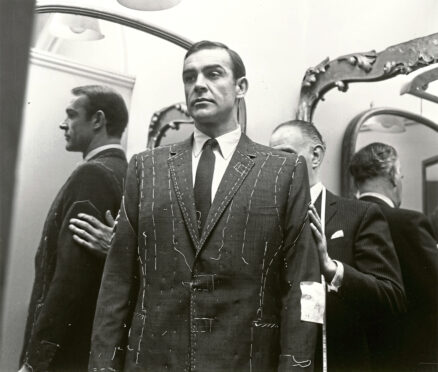
Suits are back in the frame as Daniel Craig sports his Tom Ford favourites in the latest 007 movie No Time To Die. But this classic outfit is not all about style.
Christopher Breward, director of the National Museums Scotland, tells Sally McDonald The Honest Truth about its endurance.
Why did you write this book?
I’d been researching, curating and publishing on the history of men’s fashion since the 1990s, and also loved buying and wearing suits. In the 1990s Savile Row was having a revival and suits were cool again.
I wanted to bring together my academic passion and my personal love of clothes and write a short book that brought a niche subject to life for more readers.
How long did the research take and to where did it take you?
My PhD in the early-1990s was about the culture of Victorian Dandies, so the research stretches back to then.
It involved long hours reading men’s fashion magazines and tailoring journals, looking at historical suits in museum collections (including the National Museums of Scotland) and talking to suit enthusiasts across the world.
What were your most surprising/shocking finds?
I had always thought the suit was invented in Europe in the 17th Century, but I discovered that formal men’s dress in the Indian Mughal Courts and elsewhere in Central Asia preceded and influenced its simple, elegant forms.
What was there before the suit?
In some ways the suit is the most elemental of costumes. It’s there even in pre-history. The cut and function of military uniform was also an important precedent. The lapels, skirts and pockets of modern suits are all descended from the soldier’s uniform.
When, where and how did the suit first make its appearance?
It was first introduced as formal wear for male courtiers at the Courts of Charles II in London and Louis XIV in Versailles in 1666, but became the sober suit of merchants and protestant religious groups around the same time.
What part did Scotland play, if any, in its development?
Savile Row would not be half so influential without the tweeds produced in Scotland. In the 19th Century the romance of the Borders and Highlands fuelled the fashion for woollen cloth reminiscent of heather and peat.
Scotland has also produced some of the most iconic suit wearers in history, from Conan Doyle’s Sherlock Holmes to Ian Fleming’s James Bond.
Why is its emergence significant in society?
The suit coincides with the big themes of modernity and appears to be ubiquitous across the world. Everyone has some opinion or memory of the suit.
How does it reflect societal change?
The suit is picked up by many commentators and critics as the symbol of the current mood, whether that’s ideas around conformity, democracy or subversion. It seems to stay the same, but the meanings attached to it change constantly.
How has it been used to subvert these ideas or challenge the status quo?
Avant-garde artists like the constructivists and futurists of the 1910s and 20s were fascinated by the suit and its revolutionary potential. Chairman Mao made a political hammer out of it. Marlene Dietrich shocked cinema goers by adopting it.
What is the future for the suit?
The Covid-19 pandemic has left us wearing informal dress. But there may be a hunger for formality as a reaction to all that sportswear.
Technical innovation has changed the suit over recent years, making it lighter and easier to clean. And the suit has been a sustainable form of clothing, handed down from father to son. So I think there is a future.
Will there ever be a time when suits are a thing of the past?
The suit is the great survivor. I hope museums continue to collect them, but I also hope the great craft of tailoring continues to thrive.
The Suit: Form, Function And Style by Christopher Breward is published by Reaktion Books

Enjoy the convenience of having The Sunday Post delivered as a digital ePaper straight to your smartphone, tablet or computer.
Subscribe for only £5.49 a month and enjoy all the benefits of the printed paper as a digital replica.
Subscribe